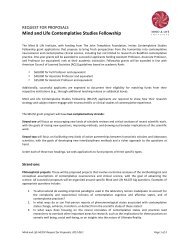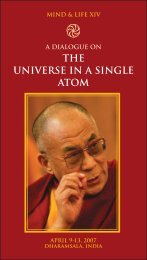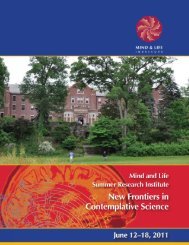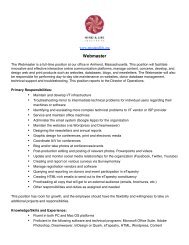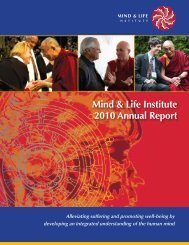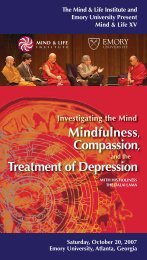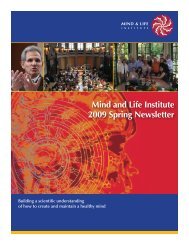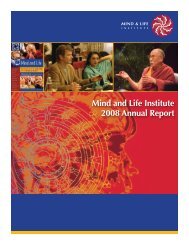to view the brochure from the conference (PDF). - Mind & Life Institute
to view the brochure from the conference (PDF). - Mind & Life Institute
to view the brochure from the conference (PDF). - Mind & Life Institute
You also want an ePaper? Increase the reach of your titles
YUMPU automatically turns print PDFs into web optimized ePapers that Google loves.
THE DIALOGUE<br />
Day One<br />
Monday, April 6 – Part I:<br />
Multi-tasking, Meditation, and Contemplative Practice<br />
Dialogue Leader: David Meyer<br />
The subjective phenomena commonly experienced by novice and intermediate<br />
practitioners during Shamatha meditation and o<strong>the</strong>r related types of contemplative<br />
practice suggest that <strong>the</strong>y may be unders<strong>to</strong>od in terms of <strong>the</strong>oretical concepts and<br />
empirical results drawn <strong>from</strong> scientific studies of human multi-tasking. Perhaps<br />
practitioners routinely engage in multi-tasking during <strong>the</strong>ir meditative sessions; while<br />
one of <strong>the</strong>ir tasks involves doing <strong>the</strong> meditation itself, ano<strong>the</strong>r probably involves<br />
performing “<strong>the</strong> task of life”, which is perpetually underway and entails many ongoing<br />
mental activities such as retrospecting, evaluating, imagining, planning, day<br />
dreaming, self moni<strong>to</strong>ring, and so forth. Becoming a skilled practitioner who is better<br />
able <strong>to</strong> maintain focused attention, <strong>to</strong> dispel <strong>the</strong> fog of mind wandering, and <strong>to</strong><br />
transcend mental distractions would <strong>the</strong>n depend on developing new task-scheduling<br />
strategies and mechanisms of cognitive control whereby meditation evolves <strong>to</strong> be a<br />
primary task and “<strong>the</strong> task of life” ceases <strong>to</strong> be even a background secondary task.<br />
What have cognitive psychologists and neuroscientists discovered about <strong>the</strong> nature of<br />
multi-tasking relevant <strong>to</strong> <strong>the</strong>se considerations and prospects Specifically we will<br />
consider <strong>the</strong> inefficiencies of multi-tasking, <strong>the</strong> components of human information<br />
processing that underlie <strong>the</strong>m, <strong>the</strong> roles played by alternative types of scheduling<br />
strategies, <strong>the</strong> contributions due <strong>to</strong> various types of working memory, and <strong>the</strong> sources<br />
of individual differences in <strong>the</strong>se related realms. It will be explained how this<br />
analysis may dovetail closely with some classical Buddhist accounts concerning<br />
stages of skill acquisition in Shamatha meditation, and with principles of optimal<br />
“cross-training” in a variety of contemplative practices <strong>to</strong> maximize <strong>the</strong> rate at which<br />
meditative skill is attained. Questions <strong>to</strong> be discussed include: do any Buddhist sutras<br />
or o<strong>the</strong>r scriptures discuss <strong>the</strong> <strong>to</strong>pic of multi-tasking If so, what do <strong>the</strong>y say about it<br />
Do any of <strong>the</strong> major traditional types of Tibetan Buddhist meditation require or<br />
encourage multi-tasking while <strong>the</strong>y are being practiced Can certain types of<br />
meditation enable people <strong>to</strong> become better at multi-tasking If so, in what ways<br />
Part II:<br />
The Buddhist Contribution <strong>to</strong> First-Person Cognitive Science<br />
Dialogue leader: B. Alan Wallace<br />
The primary methods of <strong>the</strong> modern cognitive sciences for investigating <strong>the</strong> mind are<br />
interrogation of o<strong>the</strong>rs concerning <strong>the</strong>ir subjective experience, behavioral studies,<br />
and brain research. All <strong>the</strong>se methods are indirect methods for understanding <strong>the</strong><br />
mind by way of its verbal and behavioral expressions and neural correlates. Although<br />
<strong>the</strong> direct observation of mental states and processes was prevalent in late 19thcentury<br />
psychology, introspection has been marginalized since <strong>the</strong> early 20th century.<br />
Never<strong>the</strong>less, without relying on first-person report, studies of behavior and <strong>the</strong> brain<br />
alone would yield little if any insight in<strong>to</strong> <strong>the</strong> nature of mental phenomena. While<br />
Buddhism lacks any quantitative behavioral science or neuroscience, it has<br />
developed highly sophisticated methods of introspective inquiry based on <strong>the</strong><br />
refinement of attention and metacognitive skills. These methods allegedly result in<br />
reliable, replicable observations regarding <strong>the</strong> origins, nature, and potentials of<br />
consciousness, as well as <strong>the</strong> inner causes of mental suffering and genuine happiness.<br />
5



